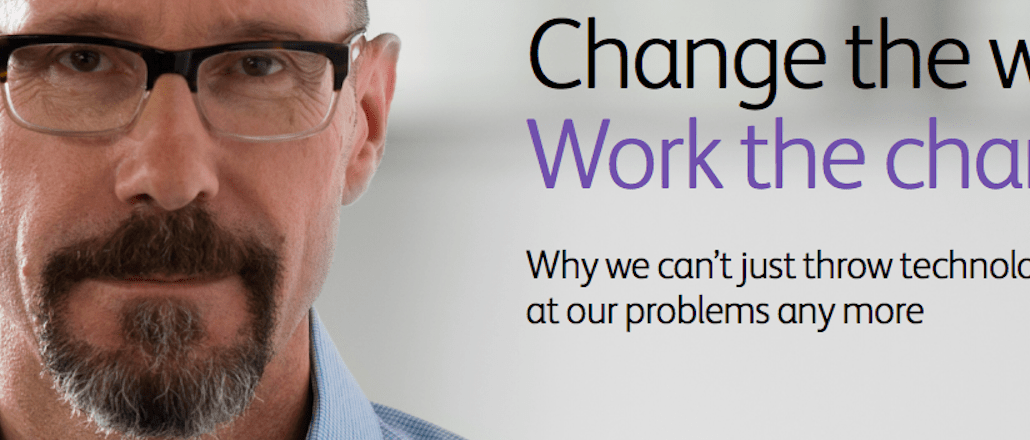Connect with execs from The New York Times, TIME, Dotdash Meredith and many more

When your brand has become synonymous with its original product, it can be tough to showcase your other offerings. Just ask Kleenex, Scotch and, well, Xerox.
Xerox is launching its latest — and biggest ever — brand overhaul, centered around the tagline “Work Can Work Better.” Out today, the rebrand includes an integrated advertising campaign across TV, print and digital media, new sponsorships, as well as a revamped website that attempts to highlight all the business services it offers to a variety of industries — from health care to manufacturing and transportation.
“Despite already being recognized as a leading global brand, there was a gap between our brand perception versus our brand reality — particularly on the services side of the business,” said John Kennedy, Xerox’s CMO. “This directly influenced the creation of a new brand strategy that defines what makes Xerox authentic, differentiates us from the competition, and makes us relevant to business and public sector leaders.”
Xerox’s business services now account for the largest portion of the company’s total revenue, according to Josh Golden, vp of global digital marketing and communications at Xerox. But for the longest time, its Web traffic hasn’t reflected that. Traffic on Xerox’s services pages has lagged far behind other areas.
Blame that on their lack of relevance and salience, say analysts.
“In terms of technology solutions for businesses, they are at the bottom of the brand resonance pyramid,” said Erich Joachimsthaler, CEO at branding firm Vivaldi Partners. “They don’t have the mindshare and visibility that IBM or Salesforce do.”
Xerox’s rebrand is a move toward being more representative of its focus areas, something it hopes to highlight through “a uniquely Xerox user-centric digital experience.” The role of digital is core to this entire effort, and the brand has launched a redesigned site. On the site, the brand is placing its bets on content to better reflect the company’s evolution into a business-services company. Through shareable stories, it is aiming to highlight these business-services offerings — from business process and document management to offering global services such as customer care centers and HR benefits management.

“Practically speaking, we’re creating content that speaks directly to our customers at eye level, not talking about ourselves,” said Golden. “And we’re doing it in part with bite-sized stories that make us relevant and easily understood. Creating and sharing really smart, really shareable content is the way you can drive value long before sales is involved.”
Xerox also realizes that today’s decision-makers have a range of technological solutions to choose from. So it wants its content to be able to provide them those “human-centered insights” that allow them to be more productive and make the right decisions. The content will be from different perspectives: the patient, the employee and even the end-user.
So visitors may find information on how health care providers and payers are working together to improve population health while controlling costs, or content on how customer service departments are using analytics and automation to predict customer behavior and deliver better customer experiences on its site. There are also the people who drive change in businesses — be it health care, government, city planning, customer care, graphic communications or HR.
“We don’t believe audiences want brand messages in their face all day long,” said Kennedy. “Our content is designed to be interesting, somewhat educational. It has a point of view; it’s intriguing. It’s not about Xerox.”
This isn’t Xerox’s first foray into publishing as a brand either. In 2013, it launched an experiential platform called HealthBizDecoded.com, which focused on the business of health care. Today, the brand recognizes that while content will live on within its website, it will also need to live on other platforms as well. It is exploring opportunities on Twitter, Facebook and LinkedIn, as well as contributed content opportunities at other publishers.
“We used to create content for content’s sake — we put up a content site that was an initial experiment in content publishing, but it wasn’t strategically connected to the brand and lines of business,” said Kennedy. “Our content strategy is now grounded in our brand strategy.”
The campaign was created by Xerox’s global advertising partner, Y&R New York, while VML and Velocity developed the new Xerox.com website experience and digital creative. MEC, Xerox’s global media agency of record, spearheaded the media strategy, planning and buying. The advertising campaign will next be launched in the U.K., and then be followed by a phased global roll-out of the new Xerox.com experience.
More in Marketing

In Graphic Detail: Inside the state of the creator economy industrial complex
The creator economy might have started out as an alternative to traditional media, but is becoming more and more like it as it professionalizes.

Shopify has quietly set boundaries for ‘buy-for-me’ AI bots on merchant sites
The change comes at a time when major retailers like Amazon and Walmart are leaning into agentic AI.

WTF is ‘Google Zero’?
The era of “Google Zero” — industry shorthand for a world where Google keeps users inside its own walls — is here.





